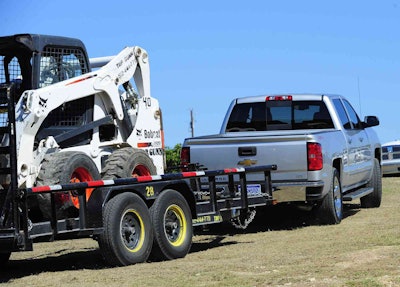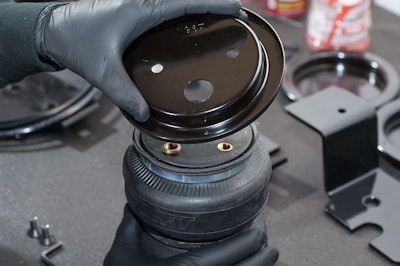
[youtube 9FE5LF2SJw8 nolink]
How to keep your truck level with a heavy load; installing Air Lift Helper Springs on a 2014 Chevy Silverado 1500
By Larry Walton, Photos by Mark Walton
Just in case you’ve forgotten that your pickup is carrying a heavy load, plenty of oncoming cars will let you know by flashing their brights. They don’t seem to care that getting these tools and supplies to the jobsite makes their drive possible.
What do they see that you can’t? Although your headlights are on low beam, your truck is squatting under the load so you’re lighting them up in ways they don’t appreciate.
Half-ton pickups are more capable today than ever when it comes to carrying payloads and towing trailers. The 2014 Chevy Silverado 1500 is no exception. This truck has been tested and approved to carry up 1,974 lbs or tow 9,600 lbs.
But towing and/or hauling at capacity can give any light-duty truck a bad attitude if the truck isn’t properly equipped, compressing the rear springs enough to make the rear squat enough to put the headlights high on the horizon. Such a load also makes the steering a bit light and cornering even more interesting with body roll.
The smooth , comfortable ride of the empty truck gives way to a hand full of driving challenges when you put a lot of tongue weight on the hitch or a big load in the bed.
The solution to keeping heavily laden pickups on the level? Air helper springs.
Air helper springs don’t increase the GVWR, the tow rating or load carrying capacity. All they do is level the truck.
One of the best air-helper springs on the market are the Load Lifter 5000 Ultimate Adjustable Air Helper Springs by Air Lift.
At the core of the kit are convolute bellows constructed much like a tire with layers of rubber and cord that allow them to be inflated up to 100psi – filling the gap between the truck frame and axle with the controlled amount of you choose.
The purpose of the air spring system is not to increase the cargo and tow capacity of the vehicle, but to improve safety and comfort.
 A properly equipped, or setup, truck will tow the heavy load on an even keel.
A properly equipped, or setup, truck will tow the heavy load on an even keel.It only makes sense that a spring setup that is best for empty truck ride comfort may not be optimal when the truck is loaded to capacity. A system that can be adjusted for whatever the load requires makes a lot of sense and this system does it well.
The Load Lifter 5000 works well as a stand-alone unit with tire-like air inflation valve stems to make quick and easy adjustments with a tire chuck and tire gauge.
However, we stepped it up a notch by also installing Air Lift’s Wireless Remote Air onboard air system with remote control.
This system’s built-in air compressor and sophisticated wireless manifold provides on-the-fly adjustments. The operator can also adjust air pressures (and thus the ride height) with the use of a remote control unit outside of the vehicle where he can see the results and fine tune as needed.
Both kits were quite complete with top quality components that were easily installed.
The system we installed on this truck has worked flawlessly in a variety of conditions and under a range of loads from completely empty to a payload of 1000 lbs while towing a trailer that weighs 7,000 lbs.
 Air Lift Load Lifter 5000 air-helper springs give big boost to level pickups.
Air Lift Load Lifter 5000 air-helper springs give big boost to level pickups.The only real challenge we faced was deciding where to put the compressor and manifold. I tried several locations in the engine bay before settling on a gusset under the truck.
The compressor has remained dry in that location despite the Oregon rain, but if your truck traverses deep water regularly this may not be the spot for you.
We also followed Air Lift’s suggestion to install emergency valve stems into the system in the unlikely case of a compressor system failure. This way the air system can be filled with an outside compressor.
Our photo gallery and video give the installation details.










